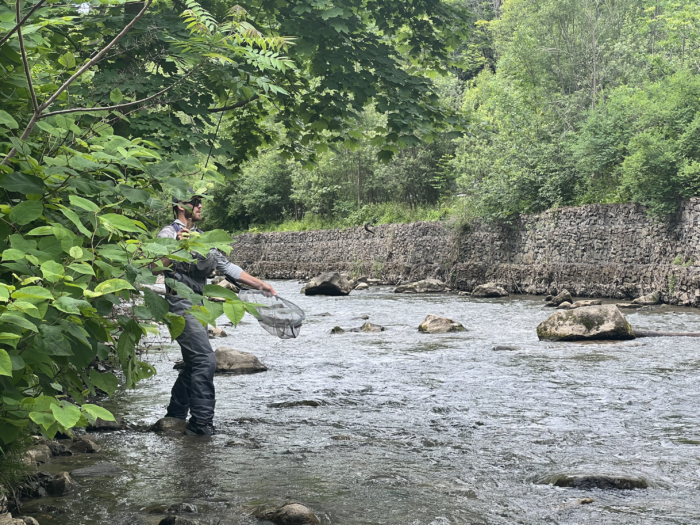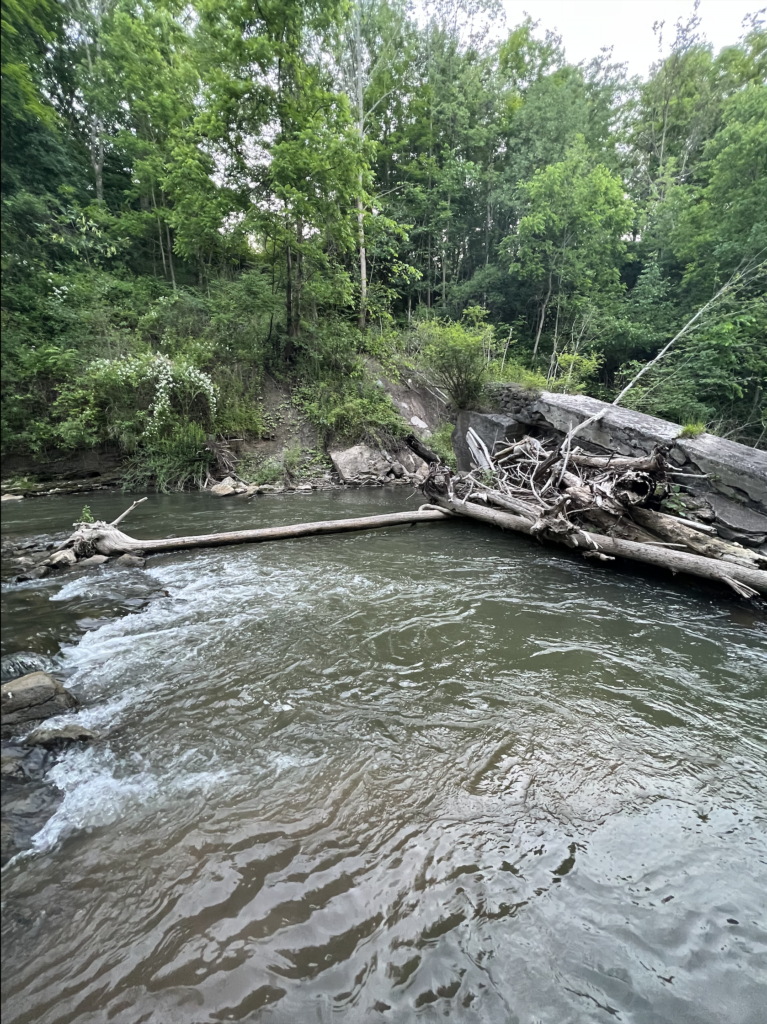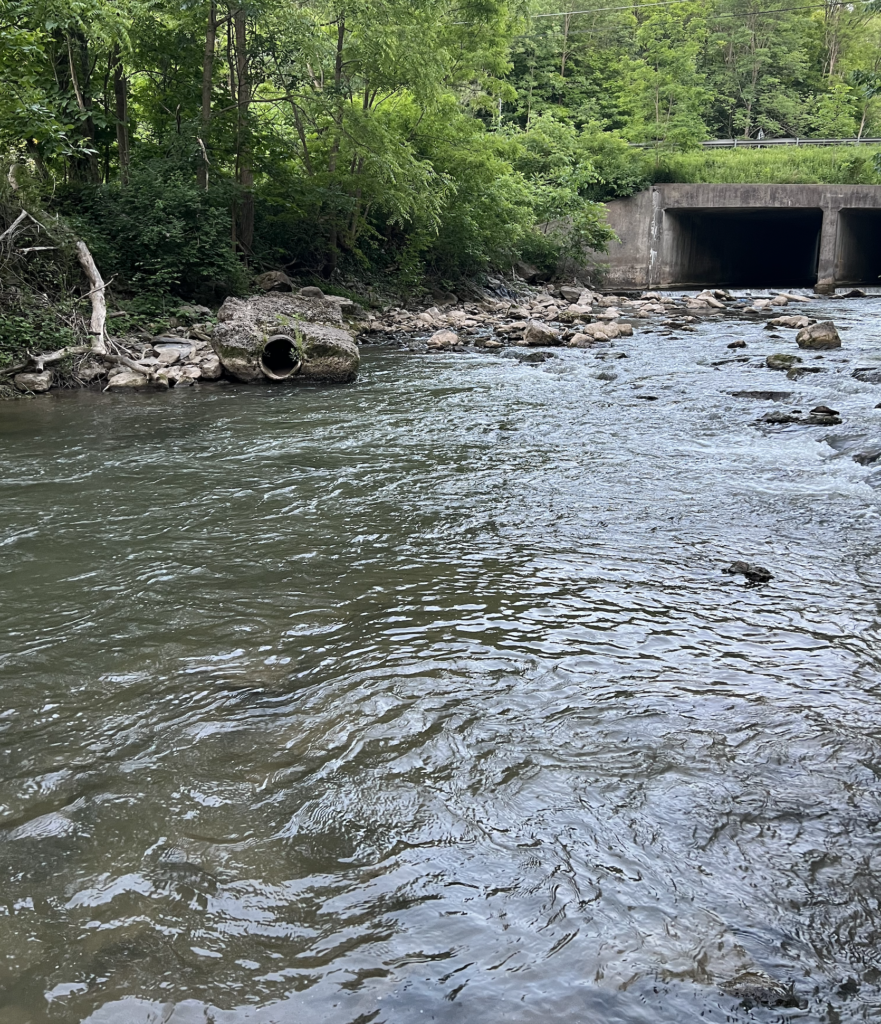
Nine Mile Mini 2022 Recap
This past weekend I competed in a one day mini competition on Nine Mile Creek in central New York. It was a fun competition with a lot of good anglers and a lot of fish, so I wanted to do a little summary of how it went and what I did to catch fish. I recently moved to Cortland, New York, only about forty minutes away from Nine Mile, but the last time I fished this creek was some time around 2017. I was going in pretty much blind, the only information I had being that the water was on the low side and the fish were eating well.
After a bit of a late start and a stop at the gas station for a healthy breakfast (Redbull and a donut), I pulled into the parking area for beat eight to “control”, or judge, a fellow competitor. I always prefer to control instead of fish the first session, because it gives me the opportunity to see how many fish I should expect to catch, where they are, and how to fish for them. After the seeing how the session went, it seemed like it would take around thirty fish to win a session and that they were pretty eager to eat anything. I also found out that the competitor that won that session caught twenty eight fish on beat four, the beat I was about to fish. The good thing about this was that I knew the beat had plenty of fish, the bad thing was that a lot of them had been caught.
Session One
My beat was situated right below the main parking lot. Luckily, the water was pretty hard to access so it didn’t receive as much pressure as the surrounding beats. The right bank was a six or seven foot retaining wall, and the left was a section of posted property. Most of the water was relatively shallow pockets that gradually became deeper going upstream. The top of the beat was a man made horseshoe pool about four feet deep that was heavily stocked in the season. To get to the bottom of the beat, I crossed above the horseshoe and waded down the shallower left side.
I decided to start off with a single fly for efficiency, covering the beat quickly so I had time to go back and hit the best spots again. I tied a size sixteen pink tag nymph onto about three feet of 5.5x tippet, and connected it to my leader with a stopper knot. As soon as the session started, I pulled two small browns out of a pocket near the flag. Seeing how quickly the fish reset after the last session and how eager they were to eat, I knew it was going to be a good session. I worked through the lower section pretty quickly, pulling fish out of all types of water, from just a few inches to a few feet deep. I would put a cast or two in each spot with a very low sighter angle and fast lead first to get any fish that ate as soon as the fly hit. Then I would throw in a number of deep, slow drifts to pick up any fish that didn’t want to eat high in the column. It ended up being about 50/50 on what drift the fish ate.

As I got to the middle of the beat, the fishing slowed down a little. I pulled a few fish in some random spots, but not the amount I expected. I decided to stick with my rig and move on, instead of switching between flies and trying to grind for a few fish. This paid off, and I started getting more eats as I reached the upper third of the beat. However, the fish were now very “nippy”, eating so quickly that it was almost impossible to set the hook fast enough. I think this may have had something to do with the change in conditions before the coming rain. I shortened up my tippet, changed to a thinner wire hook, and started using an even faster lead on my initial drift. This helped a bit but I still missed more fish than I would have liked.
As I made it to the horseshoe pool, I added a second section of tippet to my rig for the deeper water. I put the tag fly on the dropper and a three and a half millimeter beaded chartreuse mop on point in the hopes of fooling some of the bigger stocked fish that survived trout season. Two fish ate on the first two casts with the mop, and I caught four out of the pool in total. I finished my first pass through the beat with a fish count in the low twenties and about forty five minutes remaining. I had seen a few sporadic rises on the way up, so my original plan was to cover the beat again using a dry dropper with a thinner and lighter nymph. However, after seeing the success of the mop I decided to leave my rig the way it was and test it out in the pocket water.
I ran down the left side of the beat back to the lower flag, carefully avoiding anywhere I pulled fish from on the first pass. Just like in the beginning of the session, I had immediate success in the pocket near the flag, this time on the mop. I quickly removed the dropper and shortened the tippet to help stay connected. I was a little concerned the small fish I was getting out of the skinny water would be even nippier toward the mop because of its size, but luckily this didn’t seem to be the case. It was easier to stay connected to the heavier fly and the fish ate it with more confidence, so I missed a lot less fish this time around. I worked back up the beat fast, mainly covering the best pockets. I pulled fish from all the obvious places, especially in the middle section where I had poor success earlier.

I made it back to the horseshoe pool with about four minutes remaining and thirty three fish on the board. I didn’t have time to lengthen my tippet so I made a long tuck cast to the head of the pool and sunk my sighter most of the way under the surface. The fly hit the bottom, and about halfway through the drift a good fish ate. The sunken sighter was a little harder to read, so I think I may have set the hook a moment too late. As I was bringing the fish to the net, the fly popped out and flew into the tree behind me. I lost the fish, my fly, and my tippet with a little over a minute left. I tied another mop right to sighter in the hopes I could trick a stocked fish in one or two casts before time ran out, but had no success.
When the session ended I had thirty three fish, which I figured would have me sitting pretty well. When I got back to the parking lot, I found out the angler on beat two landed thirty four fish, putting me in second place for the session. I immediately regretted not lengthening my tippet and fishing the top hole a bit better. Just that one fish I lost would have bumped me up to first.

Session Two
My second session was the latest of the day, beginning at four. I was on beat one, which luckily contained some water I had fished before in the bottom half. Only eight fish were caught there in the previous session, one of the lowest numbers overall. I set my gear at the bottom flag and walked the beat. The bottom of my beat was a large, deep hole that formed around an old concrete pillar. From this it was decent pockets and runs up to a bridge with two larger holes directly below it. The beat continued above the bridge through deeper pocket water with some nice faster runs and pools every fifty yards or so. It ended at a large man made dam with a waterfall and big pool below it. This beat was long, at least a quarter mile. The organizer told me this was intentional, as the section above the bridge had way less fish than the surrounding areas. This was a result of poor bridge design, with the shallow concrete slab under the bridge making it difficult for fish to pass over, as well as the dam at the top deterring fish from swimming downstream.
With the beat being as long as it was, my plan was to fish up thoroughly once so I didn’t waste any time running all the way back to the bottom. I started with the same rig that I began with in session one, quickly covering some structure at the bottom and moving into the deep concrete hole. I picked up a fish floating the sighter in the tailout, and slowly moved around the concrete structure to the right side. After a few casts in the best looking water, I switched back over to the mop. I pulled four fish out of the right side of the pool and one from the left, along with a few misses as the fish were still being nippy.

I fished upstream, periodically changing between the tag nymph and mop. After not touching anything in the shallower pockets, I started really getting into fish when I made it to the next run. I fished the mop all the way through it and had a hit on almost every other cast. As I was getting to the best water at the head, the skies opened up. I was treated to some incredibly heavy rain, which made it a lot harder to see the sighter and pick out good holding water. I continued fishing through it and pulled a few more fish in some heavy water on the right bank.
When I made it to the holes below the bridge, I realized they were not as good as I was expecting because the bottom was made of flat concrete. I still netted another five fish out of them, but I expected a lot more. I walked up under the bridge and began fishing some shallower pockets without any luck and chalked it up to the lower fish density on this side. Around this time, I realized the rain had dirtied the water a bit. I didn’t think much of it then because the rain had all but stopped, but over the next few minutes the water progressively turned to chocolate milk. With sixteen fish on the board and forty minutes left in the session, I knew I needed to make something happen in the poor conditions to stay on the podium.

I stuck with the mop and tried to pull something out of the largest slow pockets and seams, but couldn’t make it work. As I got near the waterfall hole at the top, I tied on a three and a half millimeter black marabou bugger hoping the fish would have an easier time picking it out from the dark water. In all honesty, I did not have much confidence, because when conditions change as rapidly as they did it usually puts the fish down hard. When I got to the tail of the big hole, I made a short cast at a rock on the right bank. Before I could jig it once, I felt weight on the line and popped a small brown into the net. With some new confidence, I covered the rest of the hole and picked up two more fish.
I had ten minutes left and didn’t feel like it would be best spent in the section above the bridge. I used a few minutes to run down to the best water in the bottom of the beat where I knew the fish density was higher. My first cast behind a large rock yielded a follow from a fish pushing twenty inches, but in my excitement I pulled the fly away too early. I fished the rest of the session with no other action, and ended with nineteen fish.
When I walked back to the parking lot I had to take a second to dump the water out of my waders and wring out my shirt. I found out that I had won the session, with the next highest number being seventeen. I was also one of the only anglers who caught fish after the water turned, with some opting to just throw in the towel when it changed. Without pushing through and grinding in the muddy water, I would have taken second in that session instead of first.
The Results
At the end of the comp, I had taken second and first in my two sessions. This gave me three placing points total, and put me in second place. The comp was won by Ashley Wilmont, who finished with two placing points. Looking back, if I had landed that one fish from the horseshoe pool I would have won the comp. This is often the way it goes, which is why we focus is much on maximizing the water we’re given and landing every fish that eats. As always, it was a blast catching up with old friends and getting on the water. Congratulations to Ashley on her first win, and I wish her good luck next month at the first annual Women’s World Fly Fishing Championships!
As always, tight lines-
Mike Komara
